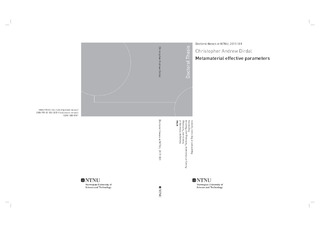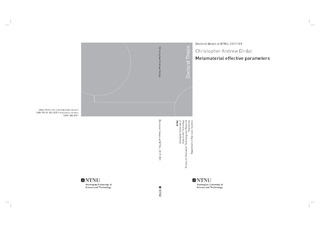| dc.contributor.advisor | Skaar, Johannes | |
| dc.contributor.author | Dirdal, Christopher Andrew | |
| dc.date.accessioned | 2017-07-06T08:47:44Z | |
| dc.date.available | 2017-07-06T08:47:44Z | |
| dc.date.issued | 2017 | |
| dc.identifier.issn | 1503-8181 | |
| dc.identifier.uri | http://hdl.handle.net/11250/2448030 | |
| dc.description.abstract | Metamaterials are a class of composite materials acting as effectively continuous media, which are capable of realizing entirely new phenomena such as negative refraction and transformation optics. They have thereby opened up for novel concepts such as the perfect lens and invisibility cloaking, which have attracted significant attention from the scientific community as well as in popular culture. The unprecedented control over field propagation offered by metamaterials naturally raises the question of what is ultimately achieveable by their use. This thesis sheds some light on this question by investigating the possibilities and limitations of the effective medium parameters _ and μ, the permittivity and permeability, respectively. The functional forms taken by these parameters directly determine the solutions of the macroscopic Maxwell’s equations, and hence the effective field behavior.
The investigations of this thesis have followed two lines of inquiry, namely causality considerations and effective medium theory. The latter approach addresses the complexities of metamaterial structures and determines how to extract effective parameters which describe their macroscopic properties, whereas the former approach avoids getting into structural detail, but rather introduces dispersion constraints such as the Kramers-Kronig (K.K.) relations.
An analytical framework relying on rational functions and polar plots is introduced to evaluate the possibility of achieving negative refraction with low loss or gain in media which abide by the K.K. relations. At the same time, this thesis argues that metamaterials attain some additional freedom in relation to the standard K.K. relations owing to the fact that they cease to be effective media at relatively long wavelengths. For instance, passive arrangements of split ring cylinders can have dispersions which are only attainable in conventional media which possess gain at high frequencies. Such relaxed dispersion constraints are characterized through the formulation of generalized K.K.-relations.
Apart from leading to K.K. relations, the principle of causality can also be used to show that any causal susceptibility function _ can be expressed as a superposition of Lorentzian response functions. This may serve to generalize typical textbook treatments of dispersion, and furthermore presents a route towards dispersion engineering: Given the abundance of metamaterial structures which give Lorentzian-like resonances, a desired dispersion can in principle be realized in terms of its decomposition into Lorentzian functions.
Using homogenization theory for metamaterials, it is shown that the permeability function does not necessarily tend to unity at large frequencies. This result serves to explain diamagnetism in passive and causal media. This thesis also discusses the importance of higher order multipole terms in homogenization theories for metamaterials. While it is common to include polarization, magnetic dipole and perhaps electric quadrupole terms, it is shown that certain higher order terms are generally significant when second order spatially dispersive effects (e.g. magnetism) are concerned. Hence, some of the underlying assumptions regarding the non-importance of such higher order terms needs to be reconsidered when applied to metamaterials. | nb_NO |
| dc.language.iso | eng | nb_NO |
| dc.publisher | NTNU | nb_NO |
| dc.relation.ispartofseries | Doctoral theses at NTNU;2017:181 | |
| dc.relation.haspart | Paper 1:
Dirdal, Christopher Andrew; Skaar, Johannes.
Negative refraction in causal media by evaluating polar paths for rational functions. Journal of the Optical Society of America. B, Optical physics 2013 ;Volum 30.(2) s. 370-376 | |
| dc.relation.haspart | Paper 2:
Dirdal, Christopher Andrew; Skaar, Johannes.
Superpositions of Lorentzians as the class of causal functions. Physical Review A. Atomic, Molecular, and Optical Physics 2013 ;Volum 88.(3) | |
| dc.relation.haspart | Paper 3:
Dirdal, Christopher Andrew; Skaar, Johannes.
Superposing Lorentzian functions towards engineering target responses. The 5th International Conference on Metamaterials, Photonic Crystals and Plasmonics Book of Abstracts 2014 | |
| dc.relation.haspart | Paper 4:
Dirdal, Christopher Andrew; Bondevik, Tarjei; Skaar, Johannes.
Relaxed dispersion constraints and metamaterial effective parameters with physical meaning for all frequencies. Physical Review B. Condensed Matter and Materials Physics 2015 ;Volum 91.(13) | |
| dc.relation.haspart | Paper 5:
Dirdal, Christopher Andrew; Hågenvik, Hans Olaf; Skaar, Johannes.
Higher order terms in metamaterial homogenization
Arxiv: 1701.01708 | |
| dc.relation.haspart | Paper 6:
Dirdal, Christopher Andrew; Skaar, Johannes.
Diamagnetism and the dispersion
of the magnetic permeability
Arxiv: 1410.5999 | |
| dc.title | Metamaterial effective parameters | nb_NO |
| dc.type | Doctoral thesis | nb_NO |
| dc.subject.nsi | VDP::Technology: 500::Electrotechnical disciplines: 540 | nb_NO |

